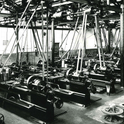Tucked away to the side of Trafalgar Square, the Sainsbury Wing of the National Gallery is an unassuming building. Your first impression might be that it’s fairly ordinary. Then you notice something weird: a row of Corinthian columns that bunch together around its face, as though there isn’t enough room to fit them all in. It’s a simple motif that hints at what this building is all about: a playful act of sacrilege that speaks to history in the same moment it attempts to upend it.
Completed in 1991 and designed by American husband-and-wife Robert Venturi and Denise Scott Brown, the Sainsbury Wing is the most iconic example of postmodernism in Britain. It is one of a handful of 20th-century buildings with a Grade I listing—which make up just 2.5 per cent of all listings in England—and one of an even smaller subset of which one of the original architects, Scott Brown, is still living. Given its importance, it’s no surprise that the announcement, in early 2021, that the National Gallery intended to renovate its interior triggered acute unease. The wing was not, after all, uncontroversial when it first opened, and the path to recognition has been long and hard fought. Would any changes be made in good faith? Five years on, that renovation is now complete. I visited the wing ahead of its reopening and met the architect who oversaw proceedings, Annabelle Selldorf, to discover what exactly has changed.
A redesign has long been on the cards. Although never meant to be the gallery’s main entrance, the wing has served this purpose de facto for decades, owing to it being the only entrance accessible from street level. As annual visitors have swelled to four million, this unintended role has put a strain on the building’s capacity. “To have people be more comfortable and feel more part of this experience is really what this is all about,” Selldorf tells me.
Selldorf is something of an architectural doyenne for the institutional art world: she’s speaking to me after finishing another major gallery renovation at the Frick Collection in New York; she has also previously worked for private gallerists David Zwirner and Hauser & Wirth. Still, this did not make her plans immune to criticism.
One of the biggest concerns was about the impact on the “anticipatory space” of the wing’s vestibule. In the original design by Venturi, Scott Brown and Associates (VSBA), the ceiling here was kept low and the lighting dim to create a purgatorial anteroom; imagine the quiet, preparatory feeling you might get as you take your seat ahead of a show at the theatre. Once ready, you were to make your way to a set of stairs. After a few steps up, you would suddenly come out from under the low ceiling and find yourself staring at what was in fact a grand staircase climbing, uninterrupted, three floors towards the galleries above and, by extension, to the heavens. In a building that revels in sleights of hand, this trick is its signature. And Selldorf agrees: “So much of this building is about going up this incredible stair and to a formidable collection,” she says.
It was to this anticipatory space, however, that Selldorf sought to make her most significant changes. In plans first made public in 2021, she proposed cutting away a large portion of the wall beside the staircase, turning the restaurant on the first floor into a partial mezzanine that looks down into the vestibule over a glass balcony. Other changes included a paler surface for the floor; removing some of the larger columns from the vestibule, which were not structural but included to enhance the sense of compression; and lightening the glass on the windows that flank the staircase on its eastern side.
The outcry was swift. The Twentieth Century Society, which campaigns for the preservation of important British architecture, said Selldorf’s changes “will involve substantial and unjustifiable harm to this Grade I listed asset”; eight former presidents of the Royal Institute of British Architects wrote that the plans made “a finely conceived space into an airport lounge”. But perhaps the fiercest critic of all was Scott Brown herself. “Much of this carefully orchestrated movement of the visitor through the building will be lost,” she wrote for the architecture journal Mas Context. Her conclusion was unambiguous: “Refusal of these applications is the only appropriate decision.”
Although Selldorf tweaked her design in response to these concerns, the mezzanine remained steadfast. Standing in the new wing many years later, looking up at the new glass balcony, it’s odd to think how such a simple thing could cause so much controversy. But just like the wing’s unassuming exterior, the more you look at it, the more radical a change it becomes. “You have more perspective as a result of the double-height space,” Selldorf tells me, alluding to another side effect of removing the wall: the windows flanking the stairs are now also more exposed to the vestibule, letting even more of Trafalgar Square into the gallery and vice versa. “I tend to think that it’ll make people more curious and more tempted to come in.”
Experiencing the wing that day—basked, as it was, in brilliant sunshine—it’s hard not to agree that Selldorf has wielded natural light extremely well. The wing has never felt so open; for the first time, you get a sense of how large a space this is. Though I can’t help but think that this purpose is, in itself, antithetical to what VSBA had in mind—which was a vestibule that served more as a mysterious crypt from antiquity than as a window on the world.
“Tell me about that,” Selldorf says; I sense she is more than ready to take on this argument. “Have you ever entered a building through a crypt?” she asks. I confess that, no, I haven’t. “Because it doesn’t exist,” she says. Case dismissed. She points out that visitors still enter the wing under a lower section of ceiling, arguing that the only difference is that the journey from compression to release is more obvious. “That sense of compression still exists,” she says, “only now it’s not suffocating.”
When it comes to the controversy of the rework more generally—“You mean the negative press”—Selldorf is likewise unfazed, telling me that she has put the general public before personal taste. “We had an opportunity to learn from how the building was experienced by the public,” she says. “I have an enormous amount of respect for this building. The criticism felt as though people weren’t giving… not just me, but… the building the opportunity to be contemporarily valid.”
Hanging like a cloud over this discussion is one name in particular. When I ask Selldorf about Scott Brown—with whom she was in frequent contact during the design process—I sense a shift in her tone. “I think she was more fearful than she had to be,” she says. “And I’m very sorry that she couldn’t let go of that fear. I think she thought that if she just kept me in conversation, we would never do anything. Sadly, she didn’t recognise that some changes really were necessary.” (When I approached Scott Brown for comment via email, she directed me to her previous written articles, adding only: “Beyond these I have no further words; indeed I am speechless.”)
Faced by the reality of how the Sainsbury Wing is being used today, it does seem that change was inevitable. Selldorf—who gives me no reason to doubt that her respect for the wing and VSBA is anything but genuine—was perhaps the best person to lead that change. But this doesn’t mean that nothing has been lost in the process.
The Sainsbury Wing always was an anomaly of museum architecture. It never really acted like a museum, never looked how you expected one to look—whereas now it does. For a gallery director that would be cause for celebration. But for architecture enthusiasts it will surely give rise to different, perhaps more melancholy, feelings entirely.













